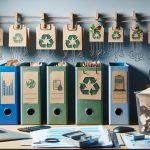We all know the importance of recycling – it’s a small but significant way to reduce waste and protect our planet. We diligently recycle paper, plastic, and glass, but what about silicone? That stretchy and versatile material found in everything from kitchen gadgets to medical devices can also be recycled. Yes, you heard that right.
But how does one recycle silicone? What are the benefits of doing so? And why is it crucial for us to incorporate this material into our recycling efforts? These are some of the questions we will explore in this blog post.
So grab your reusable water bottle and join me as we dive into the world of recycling silicone.
In this post, we will cover:
- The basics of silicone and its unique properties
- Traditional methods of disposing silicone waste
- The process of recycling silicone
- The numerous benefits for both the environment and businesses
- How individuals can make a difference by recycling silicone
By the end of this post, you’ll have a better understanding of how recycling silicone can make a positive impact on our planet. So let’s roll up our sleeves and get started.
Contents
Is silicone recyclable, and is it eco-friendly?
Silicone has a significant impact on the environment, as its production process depends heavily on non-renewable resources.
Additionally, silicone is not biodegradable and can contribute to waste and landfill issues if not disposed of properly. Though it is possible to recycle silicone, it requires specialized facilities and is often a challenging task.
However, when compared to certain types of plastic, silicone may be a more eco-friendly option due to its durability and reduced likelihood of breaking down into harmful microplastics.
The table below provides a summary of the key points regarding silicone’s environmental impact and recycling capabilities.
| Environmental Impact | Can it be Recycled? |
| Produced using non-renewable resources | Yes, but specialized facilities are required |
| Non-biodegradable | Yes, but recycling can be difficult |
| Contributes to waste and landfill problems | Yes, but mail-in programs or contacting local sanitation department may be necessary |
| Durable and less likely to break down into microplastics | Some companies offer recycling programs for their own silicone products |
| Consider switching to more eco-friendly alternatives like glass or stainless steel | Reusing or repurposing silicone items is also an option |
To reduce the environmental impact of silicone, it is important to consider switching to more eco-friendly alternatives such as glass or stainless steel.
Additionally, reusing or repurposing silicone items can help minimize waste. Some companies also offer recycling programs for their own silicone products, making it easier for consumers to recycle their items responsibly.
However, if recycling is not an option, proper disposal is crucial. This may involve participating in mail-in programs or contacting your local sanitation department for information on how to dispose of silicone items safely.
How to recycle silicone
![]()
Recycling silicone is a complex process that involves several distinct steps, each with its unique requirements and considerations.
These steps, which include sorting, cleaning, melting, and reshaping, are necessary to transform old silicone products into new ones. Let’s delve deeper into each step to better understand the intricacies involved.
| Sorting | The first crucial step in recycling silicone is sorting it into different categories based on its composition and type. This is a critical step because not all silicone products are made from the same materials and not all can be recycled in the same way. By carefully sorting the silicone, we can ensure that it is sent to the appropriate recycling facilities and processes. |
| Cleaning | Once sorted, the silicone must undergo a thorough cleaning process to remove any impurities or contaminants. This step is essential to ensure that the recycled product is of high quality and safe for use. Proper cleaning also helps to prevent any potential issues with contamination during the recycling process. |
| Melting | The next critical step is melting the cleaned silicone in specialized facilities. This process breaks down the material into its basic components, making it easier to reshape and reuse. It also helps to eliminate any remaining impurities or contaminants that may have been missed during the cleaning process. |
| Reshaping | After melting, the silicone is reshaped according to its intended use. The reshaping process can vary depending on the type of product being made, but it often involves molding or extruding the melted silicone into the desired shape. This step is where the recycled silicone transforms into a new product, ready for use. |
However, recycling silicone can be a challenging task due to limited availability of recycling facilities and contamination issues. To ensure successful recycling, it is crucial to follow proper recycling guidelines and only send clean and sorted silicone for recycling.
In addition to recycling, there are other ways to contribute to a more sustainable future when it comes to silicone products. These include reusing items if they are still in good condition, properly disposing of non-recyclable items, and choosing healthier alternatives to silicone such as glass, stainless steel, bamboo, or organic cotton materials.
Silicone: recycle, reuse, or opt for an eco-friendly alternative
Recycling silicone is a crucial step in reducing waste and preserving resources, but there are also eco-friendly options to consider. These alternatives not only reduce waste, but also promote a healthier and more sustainable lifestyle.
Opt for glass or stainless steel containers for food storage instead of plastic containers or bags. These materials are non-toxic and can be reused multiple times, reducing the need for single-use plastic.
Choose non-toxic bakeware made from ceramic or stainless steel instead of silicone, which can be harmful to the environment and our health. By doing so, we can reduce waste and reuse these materials multiple times.
Consider switching to organic cotton menstrual products like cloth pads or menstrual cups, as traditional products often contain silicone that can be harmful to the environment and our bodies. These reusable options can be washed and used multiple times, further reducing waste.
For home repairs or projects, choose water-based sealants instead of silicone-based ones. Not only are they more environmentally friendly, but they also don’t emit harmful chemicals.
While silicone straws may seem like an eco-friendly alternative to plastic straws, they still contribute to waste and pollution. Instead, opt for bamboo straws that are biodegradable and can be reused multiple times.
Also Read: How To Recycle Apple Boxes?
Conclusion
In conclusion, recycling silicone plays a crucial role in reducing waste and preserving our planet’s resources.
Despite its complexity and challenges, it is a worthwhile effort to make a positive impact on our environment. By properly sorting, cleaning, melting, and reshaping silicone products, we can give them a new life and prevent them from ending up in landfills.
However, if recycling is not an option, there are still ways to contribute to a more sustainable future by choosing eco-friendly alternatives such as glass or stainless steel containers, non-toxic bakeware, organic cotton menstrual products, water-based sealants, and bamboo straws.
These options not only reduce waste but also promote healthier lifestyles for ourselves and the planet.
So let’s continue to recycle and find creative ways to reuse or opt for eco-friendly alternatives – every small effort counts towards building a greener world.




